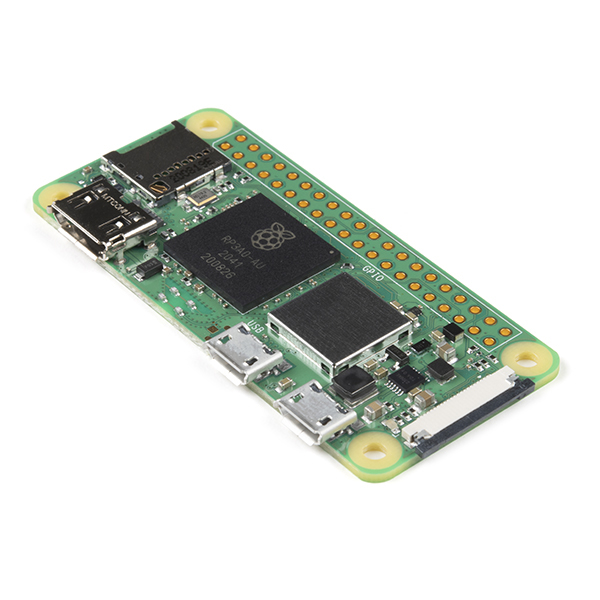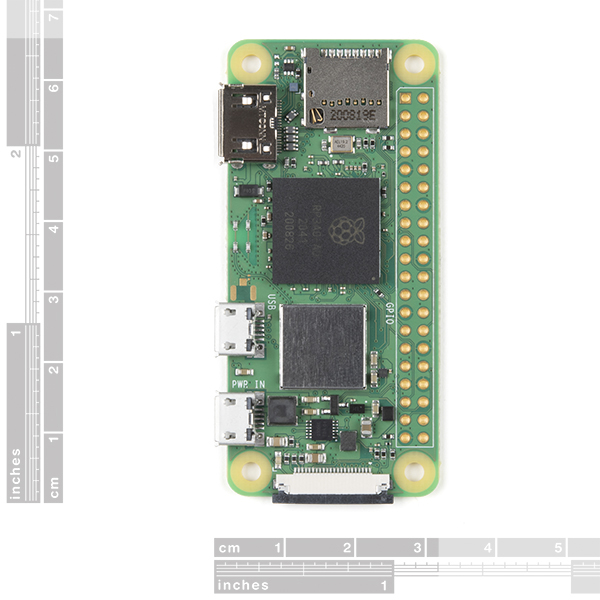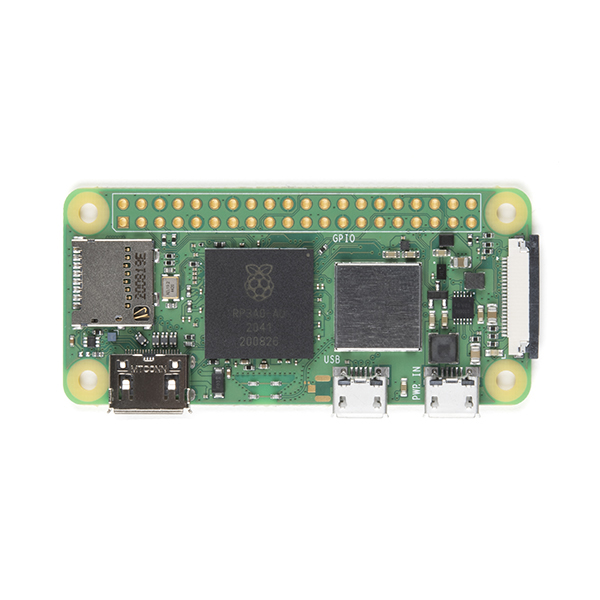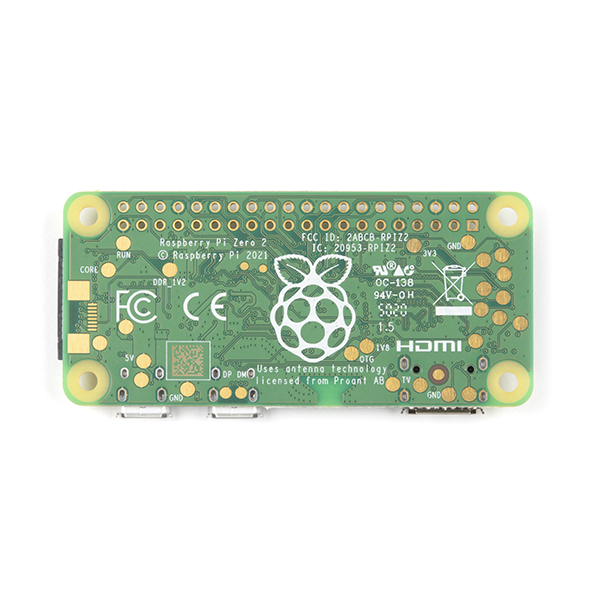The Raspberry Pi Zero 2 W is the next iteration in the Pi Zero line that remains as one of the most affordable single-board computers on the market. The successor to the breakthrough Raspberry Pi Zero W, Raspberry Pi Zero 2 W is a form factor–compatible drop-in replacement for the original board.
The board incorporates a quad-core 64-bit Arm Cortex-A53 CPU, clocked at 1GHz. At its heart is a Raspberry Pi RP3A0 system-in-package (SiP), integrating a Broadcom BCM2710A1 die with 512MB of LPDDR2 SDRAM. The upgraded processor provides the Raspberry Pi Zero 2 W with 40% more single-threaded performance, and five times more multi-threaded performance, than the original single-core Raspberry Pi Zero.
The Raspberry Pi Zero 2 W offers 2.4GHz 802.11 b/g/n wireless LAN and Bluetooth 4.2, along with support for Bluetooth Low Energy (BLE), and modular compliance certification.
The board is equipped with a microSD card slot, a CSI-2 camera connector, a USB On-The-Go (OTG) port, and an unpopulated footprint for a HAT-compatible 40-pin GPIO header. It is powered via a micro USB socket. Video output is via a mini HDMI port; composite video output can easily be made available via test points if needed.
Sharing the same form factor as the original Raspberry Pi Zero, Raspberry Pi Zero 2 W fits inside most existing Raspberry Pi Zero cases.
Important: The Raspberry Pi Zero 2 W is limited to one unit per customer account.
- Form factor: 65mm × 30mm
- Processor: Broadcom BCM2710A1, quad-core 64-bit SoC (Arm Cortex-A53 @ 1GHz)
- Memory: 512MB LPDDR2
- Connectivity:
- 2.4GHz IEEE 802.11b/g/n wireless LAN, Bluetooth 4.2, BLE, onboard antenna
- 1 × USB 2.0 interface with OTG
- HAT-compatible 40-pin I/O header footprint
- microSD card slot
- Mini HDMI port
- CSI-2 camera connector
- Video:
- HDMI interface
- Composite video
- Multimedia:
- H.264, MPEG-4 decode (1080p30)
- H.264 encode (1080p30)
- OpenGL ES 1.1, 2.0 graphics
- Input power: 5V DC 2.5A
- Operating temperature: -20°C to +70°C
Raspberry Pi Zero 2 W Product Help and Resources
Raspberry Pi Zero Helmet Impact Force Monitor
March 8, 2018
How much impact can the human body handle? This tutorial will teach you how to build your very own impact force monitor using a helmet, Raspberry Pi Zero, and accelerometer!
Setting Up the Pi Zero Wireless Pan-Tilt Camera
September 14, 2017
This tutorial will show you how to assemble, program, and access the Raspberry Pi Zero as a headless wireless pan-tilt camera.
Getting Started with the Raspberry Pi Zero 2 W
December 22, 2021
Learn how to setup, configure and use the latest version of the smallest Raspberry Pi out there, the Raspberry Pi Zero 2 W.
Core Skill: Programming
If a board needs code or communicates somehow, you're going to need to know how to program or interface with it. The programming skill is all about communication and code.
Skill Level: Competent - The toolchain for programming is a bit more complex and will examples may not be explicitly provided for you. You will be required to have a fundamental knowledge of programming and be required to provide your own code. You may need to modify existing libraries or code to work with your specific hardware. Sensor and hardware interfaces will be SPI or I2C.
See all skill levels
Core Skill: Electrical Prototyping
If it requires power, you need to know how much, what all the pins do, and how to hook it up. You may need to reference datasheets, schematics, and know the ins and outs of electronics.
Skill Level: Rookie - You may be required to know a bit more about the component, such as orientation, or how to hook it up, in addition to power requirements. You will need to understand polarized components.
See all skill levels
Comments
Looking for answers to technical questions?
We welcome your comments and suggestions below. However, if you are looking for solutions to technical questions please see our Technical Assistance page.
Customer Reviews
4.3 out of 5
Based on 32 ratings:
2 of 2 found this helpful:
great for the price .. only a few negatives
Works exactly as expected, was easy to install the raspberry OS and subsequently the pi signage software which is what I bought it for to drive a display as a digital sign for commercial application. Power consumption was low enough that I could power it from the USB port on the back of the TV I used for the digital sign. Performance was just good enough using the Pisignage software using static image files but was a bit sluggish with full HD videos which was not terribly surprising but still good enough.
A couple of relatively minor complaints:
First I really wish it used a USB C connector for one or both of the USB ports especially the DC power input. I really hate micro USB and wish all manufacturers building products with micro USB with switch to USB C.
Secondly, I hate the mini HDMI type connector wish they had used either a full-size HDMI or even a micro HDMI which is much more popular today.
I understand both of these choices are probably based on the original version of the board and changing to USB C or micro HDMI or full HDMI would render it incompatible with cases built for the original. Still would love to see both of these changes.
Of course the elephant in the room is that the availability of these boards is still really poor which means that I can't really deploy this as part of an electronic sign solution that I plan to sell too many of my customers. So it was okay as a test platform and I guess just need to wait for the covid-19 fueled semiconductor and Logistics bottlenecks to get worked out over time which is not really the fault of the raspberry Foundation but is industry wide. Hoping this situation gets worked out soon.
Overall highly recommend this board for any Raspberry Pi application where you don't need a huge amount of CPU performance or lots of memory
1 of 1 found this helpful:
Runs .net core 6
The main reason I got this was to test if .net core 6 compiled for ARM would run on this board, and it works! (The earlier versions of the Pi Zero did not have the right ARM chip)
2 of 2 found this helpful:
Faster than the Pi Zero W
Faster is better. The previous Pi Zeros were a little slow. This one is a great improvement!
1 of 1 found this helpful:
Best Pi Zero yet.
This new Pi Zero 2 is a major improvement in speed over it's previous version, you can almost smoothly surf the web with it. I am building an environmental chamber controller out of this one, and so far no issues, a great little micro controller.
1 of 1 found this helpful:
Replaced Pi Zero W
I use the Pi Zero for a headless, amateur radio application. The Pi Zero W took approximately 2.5 - 3 minutes to fully boot up and be available. The new Pi Zero 2 W boots approximately 4 times faster! It usually only takes around 30 second for it to boot up and be fully functioning.
I've also not noticed much increase in heat since my application does not have a GUI.
1 of 2 found this helpful:
One was DOA
I purchased 2 the first one was DOA I tried to reported and was told to go to the forum, to date It does not work it overheats
Sorry to hear that the device is not working properly. If you posted on the forums we can troubleshoot the unit and assist you to the best of our abilities. https://forum.sparkfun.com
2 of 5 found this helpful:
$7+ shipping for a 1 Oz item is Absurd
Paying twice the cost of a First Class package for an item that could also go into a First Class letter is kiling consumers.
Amazing product. Sparkfun let me pre-order
Appreciated Sparkfun’s purchase policy for this harder to get product.
Inexpensive and very capable!
Bought this to get back into tinkering with RPis. Love the little form factor and how little energy it uses. Not the most powerful of Pi's but for what I’ve been using it for, it’s great!
Thank you sparkfun
Finally I got this board from sparkfun for best price, while local seller in my country charge for about 4x times more. it is much faster than previous zero W
Issues with USB
I had issues with the USB port. But I was able to resolve on the forums by confusing a USB hat
Just what I needed for octopi 3D printing
The small size and having the processing power to run octopi/octoprint to control my Creality printer via wifi and usb is perfect. The fact that it also supports a inexpensive pi cam even better. Shipping was fast and like all past orders from Sparkfun I’ve made, very pleased.
Works great with Klipper
It's overkill, I know, but for Klipper it works great regardless of which Creality 3d printer it's attached. Thanks, Sparkfun, for providing inventory in such a tight market!
What I expected... Spark fun had this on back order - filled it after months
The best thing was the back order fulfillment - this was the best thing for me, I wondered if this would ever be done but it was it was great!!
Great single board computer
I love all of the raspberry Pi's, and the Zero 2 W is a great upgrade to the original Zero. It's much faster and make a great board for home projects. I just sad they are so hard to get. This is the first one I've been able to purchase in a few years.
2024 Halloween Candy Machine
I'm very excited to start next year's Halloween candy machine with this unit at the heart of the project.
The previous three machines have used a Raspberry Pi 3B which might be getting long in the tooth.
I'm going to leave that 2023 Gronk droid version intact and start a whole new build.
Love it
Much snappier than the original Pi Zero W. Was pleased to see Sparkfun had these in stock again. My only complaint is the limited purchase quantity made it very difficult to justify the shipping expense.
Great for Prusa i3 MK3S 3D-Printer
Got it to add networking and camera support to my Prusa i3 MK3S 3D-printer, and it works quite well. Now I can print without having to deal with an SD card.
Great performance
I replaced a Raspberry Pi Zero W with this and the performance improvement is noticeable. I was able to connect a Pi Camera Module v2 with no problem, and it fit in the AdaFruit case. Amazing how well this little machine works for what it costs.
Raspberry Pi Zero 2 W works just fine ... but manage swap space
I thought my new RPi Zero 2 W was defective. Tried several µSDs with fresh installs, but attempts to "apt-get update" from the initial installs failed repeatedly. But those same µSDs updated just fine on a RPi 3B+.
Sparkfun graciously sent me a replacement. But it failed in the same way.
With a bit more experimenting, I found that the default for swap space was now 100MB (!) on new installs, rather than the former twice physical memory (which would have been ~1GB). Any significant activity on a newly-installed RPi Zero 2 W failed because of lack of swap space but succeeded on a 1GB RPi because swap space wasn't needed.
So if you get a new RPi Zero 2 W, edit /etc/dphys-swapfile to either set CONF_SWAPSIZE=1000 or to comment it out and set CONF_SWAPFACTOR=2 (i.e., uncomment it).
Okay
Incredible horsepower gain over a Raspberry Pi Zero W. However it does not have enough memory to utilize it in many applications. It also typically comes at a premiun which almost doubles the cost.
Won’t connect to secured Wi-Fi AP
I bought the Pi Zero 2 W expecting it to be a higher-performance no-brainer drop-in replacement for the Pi Zero W(s) I’m using now, but it has serious problems connecting to secured Wi-Fi networks when using the standard Pi OS images. Do a web search and you’ll learn there’s maybe a 50-50 chance it’ll fail with your AP like it does with mine. All my other Pi models (and non-Pi devices as well) work fine. I’ve since bought another Pi Zero 2 W from another supplier to compare, but it fails in the same way, and I’ve returned it. The problem seems to be software/firmware, not hardware, so maybe it’ll eventually get fixed, but for now, I recommend you avoid this product.
P.S. I’ve posted to the forum to initiate a return/refund, but there’s been no response from SF. Shipping costs nearly double the cost of this board anyway, so I’m probably just stuck with this lemon.
It is about as I expected
It is slow, but serviceble. I wish that it had more ram. It does not like going online for very long, but for some simple projects it does a good job.
Fantastic Board - Running 64-bit PiOS (Bullseye)
I have a few other Pi 3B/3B+ models and have thoroughly enjoyed them. However, I like the smaller form-factor which makes it great for projects where weight/size are an issue. With 512M of RAM, there is plenty of room for programming, but you may think twice before using it as a full-desktop. It runs the PiOS desktop just fine, but if you want to launch a full, memory-hungry, browser (a chromium variant or firefox), it will be quite slow at times. But, I didn't buy it to surf the web on.
A quick overclock tweak with over_voltage=4, arm_freq=1300, core_freq=500 in /boot/config.txt brings an extra bit of pep to the Zero 2 W while still staying well within the warranty limits. (if you experience a lockup at 1300, back it down to 1200 and try again) The board, even with the overclock, runs about 4 degrees cooler than the Pi3B+ in the official case.
The microSD flash, Install and WiFi config was a breeze. Since I access this thing over ssh, I simply disabled booting the desktop and boot to console without auto-login and just use it headless.
If you are used to the Armv6 assembly on the 32-bit OS, be aware that the 64-bit os is Armv8 (Aarch64), so you will learn 64-bit Arm assembly (which is actually quite nice when you make friends with the removal of the condition-codes that were quite convenient in 32-bit Arm)
Note (Nit) the only drawback with the design pops up when you go to manually solder in the 40-pin header. Note, there are no traditional solder-pads around the pin-header holes -- just tiny copper rings. This makes it difficult to solder. Make sure you have a fine-point on your soldering iron so you can contact the ring and header-pin at the same time and use an 0.8mm or 0.6mm diameter solder. Things go fine then, just take your time and don't be afraid to redo a pin if needed.
(tip: solder a couple of pins on each row to hold the pin-header in place and then work the inside row before the outside row, generally skipping every-other pin as you work down the line to prevent localized heat build-up)
Don't forget your Goto micro-USB adapter and HDMI-microHDMI adapter and good power-supply (there are great kits that have all three and a case for about $10) Have fun!
All components work fine but ...
WiFi connection to the router is non-consistent, unfortunately. In about 12 hours WiFi access to the board becomes unavailable until board hard reset. Hope board software will be fixed soon.
Best RPI Thing I've Owned
This is the smallest most powerful device with WIFI and Bluetooth. Low power and potential for fast startups. I'm loving it.
Love this little beast!!
It's running Octoprint for my Ender 3 v2 like a champ! My only complaint is I could only buy one. Don't question if you should buy one for your project, just do it!
Great Teaching Tool
My great Nephew got the bug. I am the nerd in the family and have been playing with Pi since they first came out. He got a Zero, I ordered one so I could work with him. I have it on a MAZE Mouse I designed and we are building them somewhat in parallel 500 miles apart. I am retired but think I might get a few more to build widgets with. Great little product, but it is not a stand alone. a person needs cables, power supply, keyboard, monitor, and enough parts in a kit or otherwise to do things with it. Most of the extra stuff can be used on multiple project so is a one time expense if you get into building widgets with the various Pi.
Great service and products!
Loved the pi zero 2. Sparkfun shipped it and priced it right!




